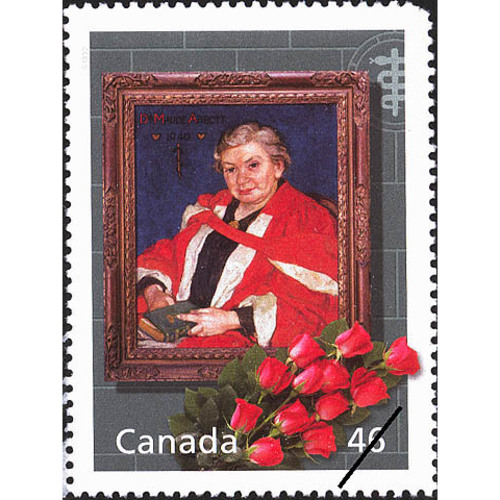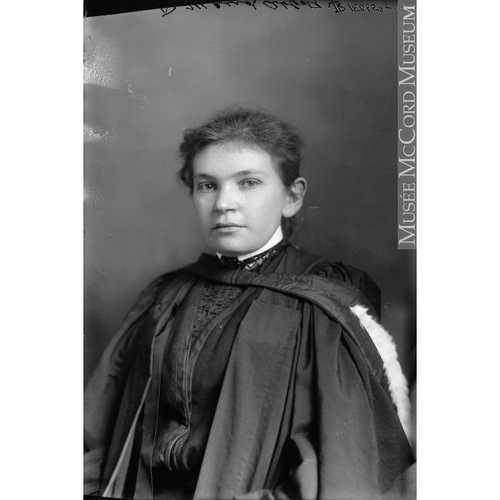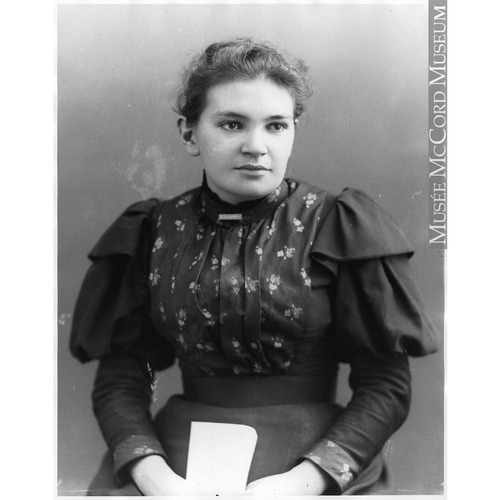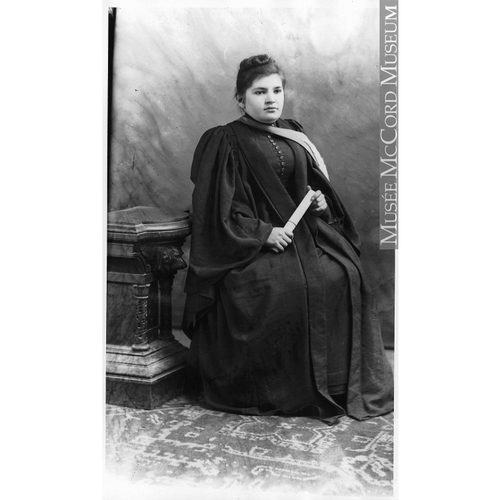
Source: Link
ABBOTT, MAUDE ELIZABETH SEYMOUR (baptized Elizabeth Maud Seymour Babin), physician, pathologist, museum curator, professor, cardiologist, author, and editor; b. 18 March 1868 in St Andrews (Saint-André-d’Argenteuil), Que., younger daughter of the Reverend Jeremie Babin and Elizabeth Bayley Abbott; cousin of John Joseph Caldwell Abbott*; d. unmarried 2 Sept. 1940 in Montreal and was buried in St Andrews.
In January 1867 Jeremie Babin, a minister of the Church of England in Buckingham (Gatineau), was tried for the murder of his crippled sister, Mary (Marie-Aglaé), who had come to live with his family a year earlier and had disappeared under mysterious circumstances the previous April. Babin was acquitted, and he went with his wife and daughter to live in St Andrews with his widowed mother-in-law, Frances Mary Abbott, née Smith. Probably in October 1868, shortly after his daughter Maude’s birth, he decamped for the United States, where he would establish a collegiate school that he directed for 14 years. Maude’s mother died of tuberculosis in October 1869, so Maude and her elder sister, Frances Alice Macdonald Babin, were raised by their maternal grandmother, and their last name was changed to Abbott.
Despite these family troubles, Maude’s childhood was happy. She received her early education at home, and in 1884–85 she attended Misses Symmers and Smith’s school in Montreal. There she was “consumed by a great thirst for the school work” and longed to continue her studies. She won the institution’s first scholarship to McGill University and entered in September 1885. Three weeks later, a smallpox epidemic in Montreal obliged her to return to St Andrews. She resumed her studies the next fall and obtained a ba in 1890 as a member of the third class of female students to attend McGill [see Sir Donald Alexander Smith*]; she was that year’s valedictorian and took home the Lord Stanley Gold Medal for academic achievement.
Ever eager for learning, Maude acted on a friend’s suggestion that she become a doctor and was encouraged by her grandmother’s comment, “Dear child, you may be anything you like.” Unfortunately, few medical faculties were so liberally minded. To Maude and other women, the one at McGill was “impenetrable” despite a fund-raising appeal by sympathetic Montreal women and assistance from some leading doctors, such as Thomas George Roddick*, who supported Maude’s request for admission. However, Bishop’s College had a medical faculty in the city [see Francis Wayland Campbell*] and it invited her to enrol. She would later recall that being “no longer within the walls of my beloved McGill,” she was lonely among “rough students” in what she described as “an alien school.” Nonetheless, she earned an md in 1894, and won the prize in senior anatomy and the chancellor’s award for the best examination results in the subjects studied in the final year. Yet even at the Montreal General Hospital, where she went for clinical work, she was not welcomed by the superintendent of nursing, Gertrude Elizabeth (Nora) Livingston*.
After graduation, Abbott spent three years in Europe, taking postgraduate courses in a wide variety of subjects, meeting well-known doctors, and collecting research data. She noted that her studies abroad in pathology and internal medicine “determined my bent and made possible my later work at McGill.” On her return to Montreal in 1897, she opened an office, but she discovered that women doctors had great difficulty making a living in private practice. Since her grandmother had died, she now had sole responsibility for her sister Alice, who had become an invalid. Undaunted by personal, financial, and professional difficulties, she seized the opportunities for research offered by two McGill professors. Dr John George Adami asked her to document rare cases of cirrhosis. Dr Charles Ferdinand Martin suggested that she undertake a statistical study of heart murmurs based on the records kept by the Royal Victoria Hospital from 1895 to 1898. With these assignments she proved her capacity for research and gained a foothold in McGill. Initially, her papers had to be read before learned societies by male colleagues, but “On so-called functional heart murmurs” earned her precedent-making membership in the Montreal Medico-Chirurgical Society in 1898 and publication in the Montreal Medical Journal the following year. A paper by Adami, Abbott, and Francis John Nicholson was read before the Association of American Physicians in 1899 and two by Abbott alone, “On the bacteriology of a case of progressive portal cirrhosis” and “Pigmentation cirrhosis of the liver in a case of haemochromatosis,” were the first to be published by a woman in the Journal of Pathology and Bacteriology (Edinburgh and London), in 1900 and 1901 respectively.
In the summer of 1898 Abbott had been appointed assistant curator of the pathological museum at McGill, a significant step in her slowly advancing career. By 1901 the collection of anatomical and pathological specimens was known as the McGill Medical Museum. Although Abbott would continue to have a small private practice for many years, partly for the income and partly because she enjoyed the work, the museum became her main preoccupation. She turned an accumulation of specimens arranged according to various methods into a well-organized collection, catalogued using a decimal system she developed from the classification used by modern libraries. She published several articles on the system, which was adopted by other institutions.
In 1899, researching ways in which to reorganize the museum, Abbott had visited various institutions in the United States. At Johns Hopkins University she met Dr William Osler*, who became her mentor and lifelong inspiration. According to her, when Osler pointed to the educational potential of the McGill museum, “He quietly dropped the seed that dominated all my future work for many years.” By using the museum as an instructional tool, she revolutionized the teaching of pathology at McGill. Initially, students were not required to attend her demonstrations, but they proved to be so popular that in 1904 they became a compulsory part of the curriculum and would remain so until 1922.
Abbott’s close identification with her work was demonstrated in the spring of 1907 when the Medical Building that housed the museum caught fire; she was one of the first to be found among the embers, trying to salvage the precious artefacts. In May she became the first secretary of the International Association of Medical Museums, a body she had worked hard to establish; she would hold the post until 1938. Her contacts with curators throughout North America and overseas helped her to rebuild McGill’s collection. She was named acting curator of the Canadian Army Medical Museum in 1918, when its collection was placed in the custody of McGill.
In 1905 Osler had invited Abbott to contribute the section on congenital heart abnormalities for his encyclopedic A system of medicine … (7v., London, 1907–10). He was extremely impressed by her piece, declaring in 1908 that “I knew you would write a good article but I did not expect one of such extraordinary merit.” In 1905 McGill had made Abbott a research fellow in pathology, in 1910 it awarded her an honorary md, and finally, in 1912, it appointed her lecturer. In 1919 she received a “very pressing and courteous invitation” from the Woman’s Medical College of Pennsylvania, in Philadelphia, offering her the professorship of pathology at double her salary. She did not accept until 1923, when she took two years’ leave. During her time there she successfully reorganized the department of pathology. She returned to Montreal as assistant professor, the highest rank McGill ever accorded her.
Throughout her life, Abbott was an indefatigable researcher, author, and editor. In addition to being secretary of the IAMM, she served as editor of its Bulletin (Baltimore, Md) from 1907 to 1938. During World War I she and Dr George Gordon Campbell took over the editorship of the Canadian Medical Association’s Journal (Toronto), although its former editor, Andrew Macphail, remained nominally in charge. In 1919, after the death of Osler, whom she called “the most beloved physician of our day,” she began work on a special issue of the IAMM Bulletin in his honour. More than six years in the making, the bulky Sir William Osler memorial number … included over 100 papers “reminiscent of every phase of Osler’s activities” and, when a reprint was needed in 1927, she even accepted ten more contributions. It was a tribute both to Osler’s distinction and to Abbott’s devotion.
Abbott’s own bibliography lists some 140 titles covering her wide range of interests, from medical museums and nursing education to pathology and heart abnormalities, as well as numerous articles and monographs such as “An historical sketch of the medical faculty of McGill University,” which appeared in the Montreal Medical Journal in 1902, “Women in medicine,” in the University Magazine (Montreal) in 1911, McGill’s heroic past, 1821–1921: an historic outline of the university from its origin to the present time (Montreal, 1921), and History of medicine in the province of Quebec (Montreal, 1931). However, her reputation as an author largely derives from her work in medical research. According to Canadian cardiologist Harold Nathan Segall, these writings represent “truly precious pioneering.” In particular, her adoption of a “physiological basis for thinking of congenital heart disease made for improved clarity in understanding diagnosis, therapy and prognosis.” Her gigantic undertaking, the Atlas of congenital cardiac disease (New York, 1936), brought her worldwide acclaim and remains a classic.
Abbott was never rich, but always spent whatever was necessary for Alice’s care until her sister’s death in 1934. A correspondence begun in 1890 with her errant father did not recreate a family, nor did a visit in 1916 from her half-brother Harry Babin produce anything more than an emotional, but brief, exchange of letters. Friends and work substituted for family, and Abbott was always warm-hearted, hospitable, and generous. This “beneficent tornado,” as distinguished Philadelphia pathologist Edward Bell Krumbhaar called her, was admired by her students and respected by colleagues throughout the English-speaking medical world. Some male McGill professors insisted on calling her “Miss Abbott” rather than “Dr Abbott” and her promotion was much slower and her salary was always lower than theirs, yet she remained unfalteringly loyal to the institution. Her devotion was acknowledged on her retirement in 1936, when the university granted her an honorary lld, recognizing her “as a stimulating teacher, an indefatigable investigator and a champion of higher education for women.”
In June 1940 Abbott suffered a cerebral haemorrhage and never fully recovered. On her death several months later, tributes poured in. During an address to the New England Heart Association in December, the eminent American cardiologist Dr Paul Dudley White ranked her as “the world’s authority on congenital heart disease …, a living force in the medicine of her generation.” She had been honoured in many ways during her lifetime, as a fellow of the Royal College of Physicians and Surgeons of Canada (1931), a fellow of the Royal Society of Medicine, London, England (1935), and an honorary member of the New York Academy of Medicine (1936). Posthumously, her achievements continued to be recognized. She was the only woman scientist and the only Canadian in Diego Rivera’s renowned mural “History of cardiology,” created for the National Institute of Cardiology in Mexico City (1944), and she was remembered in the annual Maude Abbott Lecture of the United States and Canadian Academy of Pathology. In 1994 she was the only woman among the first ten laureates of the Canadian Medical Hall of Fame in London, Ont. Near the McIntyre Medical Sciences Building on the McGill campus, a distinctive assemblage of granite slabs displays a plaque created by the Historic Sites and Monuments Board of Canada as a national tribute to her achievements.
BANQ-CAM, CE606-S34, 24 mai 1868, 13 nov. 1869. McGill Univ. Arch. (Montreal), Acc. 2354.01.2 (valedictory address by Maude E. Abbott, 1890, McGill Univ. convocation); MG 1070. McGill Univ. Libraries, Osler Library (Montreal), P111; P417. Montreal Daily Star, 3 Sept. 1930. E. L. Abbott, All heart: notes on the life of Dr. Maude Elizabeth Seymour Abbott, m.d., pioneer woman doctor and cardiologist (Sainte-Anne-de-Bellevue, Que., 1997). M. E. [S]. Abbott, “Editorial preface,” International Assoc. of Medical Museums, Bull. and Journal of Technical Methods (Montreal), 9 (1926; repr. 1927): xix–xxii, Special issue (Sir William Osler memorial number: appreciations and reminiscences). Jessie Boyd Scriver, “Maude E. Abbott,” in The clear spirit: twenty Canadian women and their times, ed. Mary Quayle Innis (Toronto, 1966), 142–57. Barbara Brookes, “An illness in the family: Dr. Maude Abbott and her sister, Alice Abbott,” Canadian Bull. of Medical Hist. (Waterloo, Ont.), 28 (2011): 171–90. Canadian medical lives, ed. T. P. Morley (24v. to date, Toronto and Oxford, Eng., 1989– ), 13 (Douglas Waugh, Maudie of McGill: Dr Maude Abbott and the foundations of heart surgery, 1992). S. B. Frost, “The Abbotts of McGill,” McGill Journal of Education ([Montreal]), 13 (1978): 253–70. Hervé Gagnon et C. D. Nadeau, “La contribution de Maude Abbott au développement de la muséologie médicale (1898–1940),” Fontanus (Montréal), 10 (1998): 71–79. Margaret Gillett, “The heart of the matter: Maude E. Abbott, 1869–1940,” in Despite the odds: essays on Canadian women and science, ed. Marianne Gosztonyi Ainley (Montreal, 1990), 179–94; We walked very warily: a history of women at McGill (Montreal, 1981). H. E. MacDermot, Maude Abbott: a memoir (Toronto, 1941). Raymond Ouimet, La mystérieuse affaire Babin: une énigme enfin résolue (Montpellier, Québec, 2007). H. N. Segall, Pioneers of cardiology in Canada, 1820–1970: the genesis of Canadian cardiology (Willowdale, Ont., 1988).
Cite This Article
Margaret Gillett, “ABBOTT, MAUDE ELIZABETH SEYMOUR (baptized Elizabeth Maud Seymour Babin),” in Dictionary of Canadian Biography, vol. 16, University of Toronto/Université Laval, 2003–, accessed January 1, 2026, https://www.biographi.ca/en/bio/abbott_maude_elizabeth_seymour_16E.html.
The citation above shows the format for footnotes and endnotes according to the Chicago manual of style (16th edition). Information to be used in other citation formats:
| Permalink: | https://www.biographi.ca/en/bio/abbott_maude_elizabeth_seymour_16E.html |
| Author of Article: | Margaret Gillett |
| Title of Article: | ABBOTT, MAUDE ELIZABETH SEYMOUR (baptized Elizabeth Maud Seymour Babin) |
| Publication Name: | Dictionary of Canadian Biography, vol. 16 |
| Publisher: | University of Toronto/Université Laval |
| Year of publication: | 2016 |
| Year of revision: | 2016 |
| Access Date: | January 1, 2026 |







